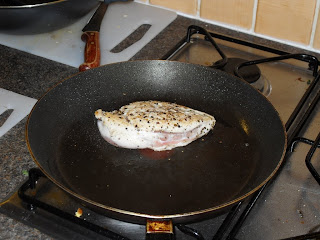 Roast chicken is something of a British classic in my opinion - and very simple to do! Simply take a chicken, season it with salt, freshly ground black pepper and some herbs. In this case, I've used parsley and basil, which I find add a good flavour to most dishes. Chop a couple of carrots, an onion and some celery and place around the chicken, as shown in the picture. The idea of these vegetables it add flavour to the gravy, which we will make from the juices that come from the meat. I usually lightly drizzle olive oil over the chicken and the vegetables as well. Then, simply place in the oven. It's best to follow the cooking guidelines on the label of the chicken as times will vary depending on the size.
Roast chicken is something of a British classic in my opinion - and very simple to do! Simply take a chicken, season it with salt, freshly ground black pepper and some herbs. In this case, I've used parsley and basil, which I find add a good flavour to most dishes. Chop a couple of carrots, an onion and some celery and place around the chicken, as shown in the picture. The idea of these vegetables it add flavour to the gravy, which we will make from the juices that come from the meat. I usually lightly drizzle olive oil over the chicken and the vegetables as well. Then, simply place in the oven. It's best to follow the cooking guidelines on the label of the chicken as times will vary depending on the size.As it's cooking, take it out of the oven a couple of times to baste it. Simply tip the tray up and use a spoon to cover the roasting chicken with the juice that will have formed in the tray. Once the chicken is cooked, it's time to make the gravy. This is really easy and I don't know why more people don't make their own gravy when the cook a roast - the flavour is so much better then the dried gravy granules that you can buy. Remove the chicken from the tray and leave on a plate to rest, covered with a sheet of kitchen foil to keep the heat in. Using a sieve, strain out the contents of the roasting tray into a suitable container, such as a measuring jug. Then, pour a few table spoons of cold water into the roasting tray and stir this around to pick up the last of the juices. Pour this into measuring jug with the rest of the strained juice. You will probably find that the gravy separates into two layers, the top one of which is fat. It's probably not a good idea to have too much fat in your gravy, so you can use a spoon to carefully remove as much of this layer as you can. Once that's done, you can thicken the gravy if you want. To do this, simply mix a little flour into some cold water in a cup. Then, place the gravy into a small pan on a low heat and slowly add the flour and water mixture whilst stirring, until you get the desired consistency. That's it! It might sound a lot, but it really is very simple and the same procedure can be used to make gravy from other meats as well as chicken, such as roast beef.
I like to keep a roast simple, so in this case I served it with boiled potatoes, English green cabbage
 One of the great things about roast chicken is that you can use all the left overs to make the most amazing fresh chicken stock, but I'll cover that in another post. Enjoy!
One of the great things about roast chicken is that you can use all the left overs to make the most amazing fresh chicken stock, but I'll cover that in another post. Enjoy!




